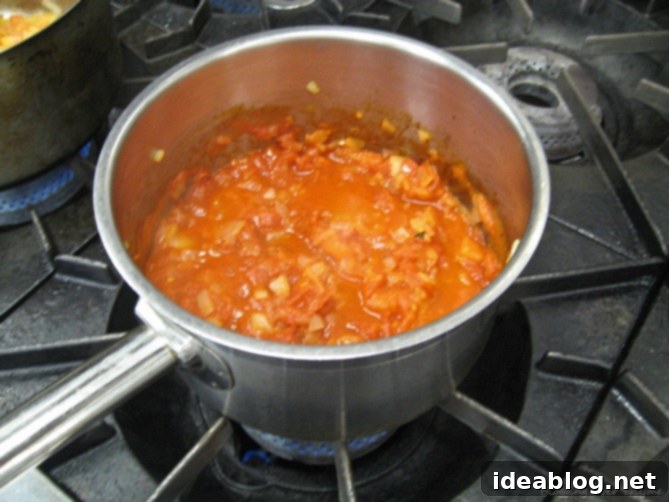Mastering Culinary Arts: Crafting Exquisite Homemade Ravioli, Slow-Cooked Eggs, and Classic Desserts
Another exhilarating and incredibly productive day unfolded in the culinary school kitchen, brimming with diverse lessons and hands-on experiences. Today marked a significant milestone: our first foray into making **homemade ravioli** entirely by hand. This exciting challenge not only allowed us to refine our pasta-making skills but also provided a deeper understanding of dough consistency and texture. While I’ve attempted ravioli at home previously, my reliance on a ravioli mold proved less than ideal, offering limited control over the final product. The professional kitchen environment, however, provided the perfect setting to learn the artisanal method, emphasizing precision and the delicate touch required for perfect pasta, a foundational skill in Italian cuisine.
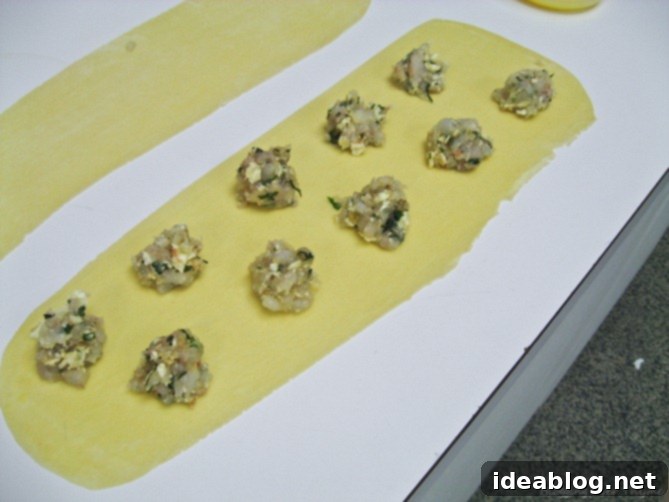
The Art of Homemade Ravioli: A Unique Filling and Hand-Crafted Perfection
Our ravioli filling was truly exceptional, boasting a sophisticated blend of flavors and textures designed to delight the palate. We meticulously prepared finely chopped raw shrimp, ensuring it was thoroughly deveined for optimal taste and presentation. This delicate protein was then combined with fragrant fresh basil, finely minced shallot, aromatic garlic, and a crucial addition: small cubes of cold butter. The butter, as we learned, is essential for providing richness and a silky texture to the filling as it gently cooks within the pasta pocket. To introduce a subtle kick and enhance the overall complexity, we incorporated a hint of Tobasco sauce, elevating the flavor profile without overwhelming the delicate shrimp. As depicted in the accompanying image, the small white specks visible within the filling are indeed those vital pieces of cold butter, promising a luxurious mouthfeel and adding moisture.
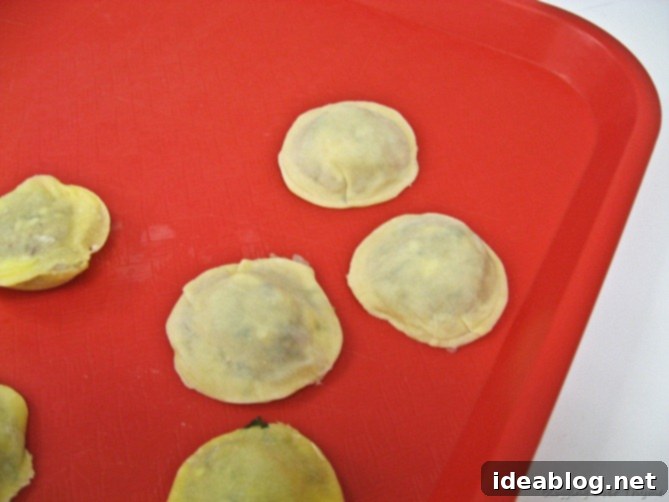
From Dough to Dumpling: Mastering the Hand-Rolling and Shaping Technique
The process of forming the ravioli by hand was an exercise in patience and finesse, a true test of culinary dexterity. After carefully rolling out our fresh pasta dough into remarkably thin, translucent sheets—a key to delicate ravioli—we began the assembly. The unique filling was strategically staggered onto one sheet of pasta, leaving ample space between each mound for sealing. We then lightly brushed the surrounding pasta with egg yolk, acting as a natural adhesive that ensures a tight seal. The top sheet of pasta was then painstakingly laid over the filling, and with gentle but firm pressure, we carefully crimped the pasta around each mound, expelling any air pockets to prevent them from bursting during cooking. For precise shaping, we employed a small round biscuit cutter to press down firmly and begin forming the individual ravioli, followed by a *larger* biscuit cutter to cleanly cut them. The final touch involved pinching the edges with our fingers, creating a beautiful, sealed border that is both aesthetically pleasing and structurally sound. Chef Brian reiterated a fundamental principle of superior ravioli: the pasta itself should be incredibly thin, ensuring that the true star of the dish remains the flavorful filling. This emphasis on the filling allows its unique qualities to shine through, rather than being overshadowed by thick, doughy pasta, a common pitfall in amateur pasta making. This meticulous hand-crafting technique ensures a superior culinary experience.
Elevating Flavor: The Basil Cream Sauce and Its Culinary Nuances
To complement our exquisite homemade ravioli, we prepared a classic French accompaniment: **LA SAUCE CRÈME AU BASILIC**, a rich and aromatic basil cream sauce. The creation of this sauce began with a foundational step often overlooked in home cooking: lightly sautéing the shrimp shells. This technique, known as creating a *fond*, extracts incredible depth of flavor from the shells, infusing the sauce with an intense seafood essence and adding a layer of umami. To this aromatic base, we added more finely diced shallot, garlic, and fresh basil, building layers of complex flavor. White wine was then deglazed into the pan and cooked down **au sec**, meaning until it was almost completely dry. This crucial step concentrates the wine’s flavor, removing its harsh alcoholic notes and leaving behind a beautiful, nuanced acidity. Just before serving, we whisked in heavy cream, allowing it to gently thicken to a velvety consistency, and finished the sauce with a generous scattering of chiffonade basil and freshly grated Parmesan cheese. The resulting sauce was smooth, fragrant, and undeniably luxurious, perfectly coating each delicate ravioli.
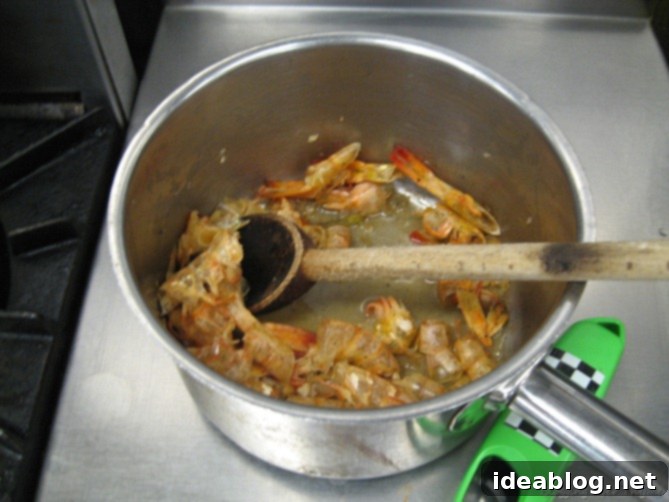
The finished dish, with its plump, perfectly cooked ravioli and rich cream sauce, was a testament to our efforts and skill development. While the ravioli themselves were excellent and the sauce well-executed, I personally find myself leaning towards lighter sauces for pasta dishes. For my palate, these delicious shrimp ravioli would be equally, if not more, enjoyable with a simple drizzle of browned butter, a squeeze of lemon, and a generous sprinkle of Parmesan cheese, allowing the delicate shrimp flavor to truly sing. This dish, however, is incredibly versatile; the shrimp filling could easily be substituted with finely diced raw lobster meat for an even more luxurious experience, or perhaps chicken, pork, or even a vegetarian squash and ricotta filling. The foundational techniques remain the same, offering endless possibilities for culinary creativity and adaptation. I am eagerly looking forward to experimenting with more homemade ravioli variations in the future, confident in my newfound skills and understanding of pasta making.
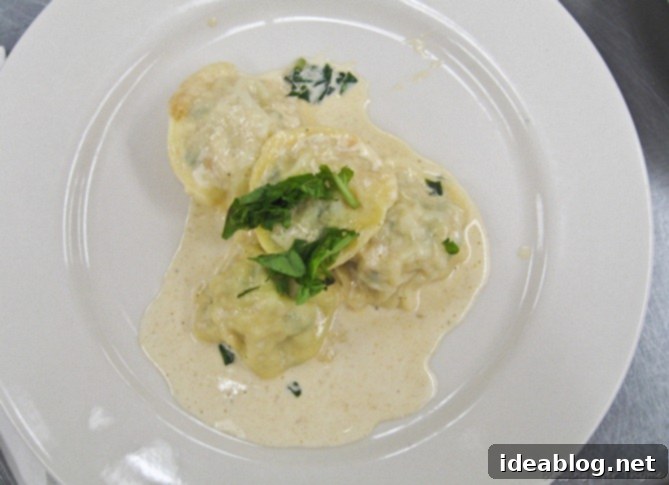
Beyond Pasta: The Art of Slow-Cooked Scrambled Eggs
Despite appearing to be from a completely different culinary realm than handmade pasta, we also embarked on a fascinating and invaluable lesson in making **scrambled eggs**. However, this wasn’t just any scrambled egg technique; it was a profound demonstration of how meticulous low-heat cooking can transform a simple protein into something extraordinary. This specific method results in incredibly tender, unbelievably creamy, and almost custardy scrambled eggs, achieved without adding any dairy or other ingredients beyond the eggs themselves. It’s a testament to the power of patience, controlled temperature, and precise technique in creating sublime textures and highlighting the natural richness of the eggs.
The Bain Marie Method for Velvety Eggs: A Masterclass in Texture
The process for these remarkable scrambled eggs began by whisking a generous quantity of fresh, high-quality eggs until thoroughly combined and slightly aerated. They were then strained to remove any chalazae or membranes, ensuring a perfectly smooth and uniform base free of any textural inconsistencies. The prepared egg mixture was then poured into a large stainless steel bowl, which was meticulously positioned over a *bain marie* – essentially a water bath with gently simmering water. The indirect heat from the steam slowly and evenly cooks the eggs, preventing them from overcooking or becoming rubbery. This method is anything but quick; it took us approximately 40 minutes of continuous cooking to achieve the desired delicate, custard-like consistency, making it entirely unsuitable for a last-minute breakfast. Moreover, it demands constant, gentle stirring with a rubber spatula, ensuring even cooking and preventing any part of the eggs from sticking to the bowl or scrambling too quickly. My dedicated kitchen partner, Lindsay, and I had to coordinate our efforts, taking turns stirring while managing other concurrent tasks in our bustling kitchen environment. The reward, however, was a batch of scrambled eggs unlike any I had tasted before: incredibly delicate, uniform, and wonderfully luxurious, a true revelation in egg preparation.
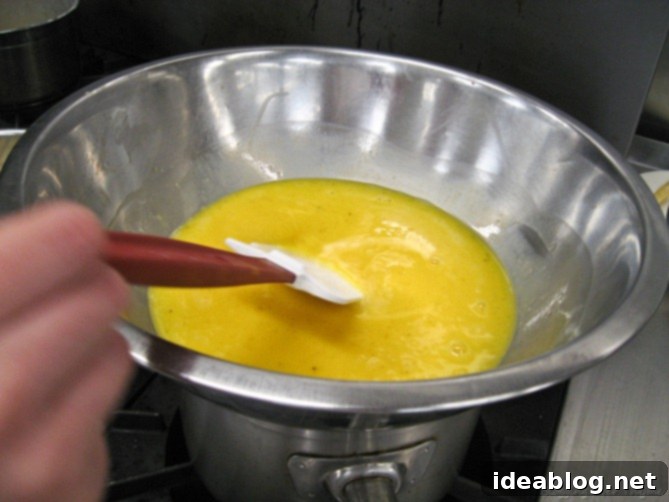
Our perfectly slow-cooked scrambled eggs were elegantly served with a topping of **tomato concasse**. This vibrant and fresh accompaniment is essentially a rustic tomato sauce made with finely diced onions, both fresh and canned tomatoes, and notably, it is *not* passed through a food mill. The deliberate intention behind a concasse is to preserve its natural texture and freshness, offering a bright, acidic, and slightly chunky counterpoint to the sublime richness of the eggs. The natural acidity and vibrant freshness of the tomato cut beautifully through the custardy eggs, creating a balanced and delightful flavor combination that cleanses the palate with each bite.
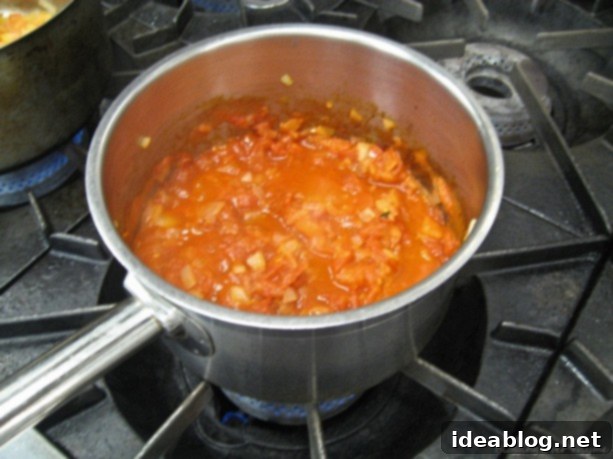
Classic Accompaniments: Perfectly Golden Pommes Frites
As if the day hadn’t been decadent enough with cream-laden ravioli and rich, slow-cooked eggs, we also revisited the timeless technique for crafting homemade **POMMES FRITES**, or classic French fries. This review served to reinforce our understanding of the critical double-frying method, a fundamental technique that ensures a perfectly crisp, golden-brown exterior and a fluffy, tender interior. Preparing these golden delights alongside the other dishes highlighted the importance of versatile frying skills in a professional kitchen, ensuring every component of a meal is executed with precision and consistency. The delightful contrast between the soft, custardy eggs and the crispy, salty fries offered a satisfying textural interplay that elevated a seemingly simple side dish to a gourmet experience.
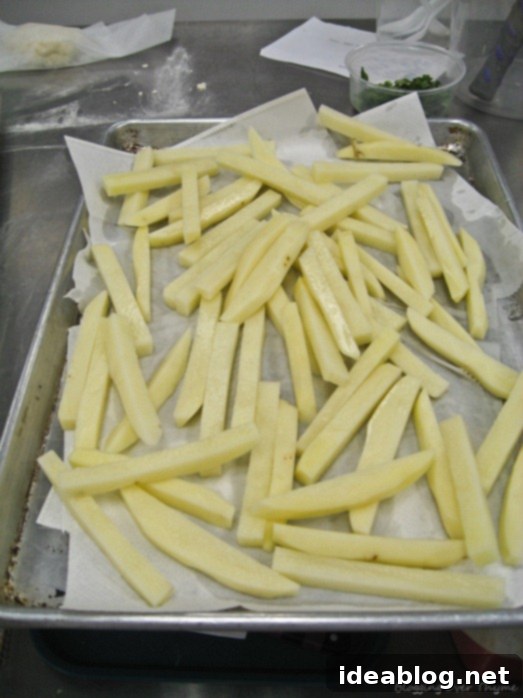
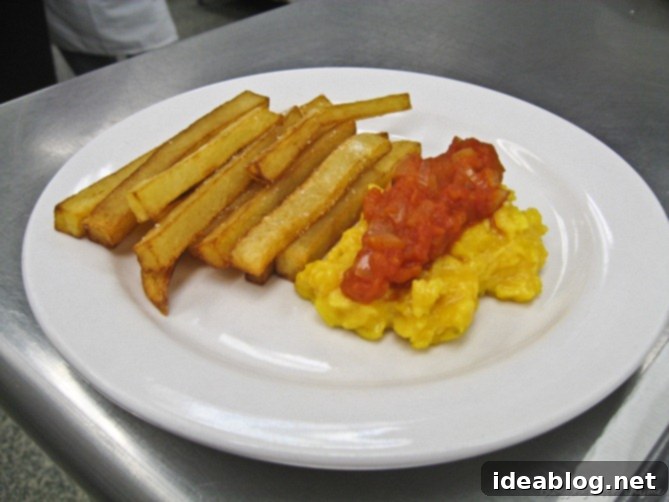
A Sweet Finale: Brownies, Tuille Cookies, and Homemade Ice Cream
Our comprehensive culinary journey for the day concluded with a delectable array of desserts, showcasing our growing pastry skills. We prepared a batch of classic **basic brownies**, renowned for their rich chocolate flavor and intensely fudgy texture, a perennial favorite. These indulgent treats were served alongside delicate cigarette cookies, also known as *tuille* cookies, and a generous scoop of freshly churned ice cream. The ice cream, expertly prepared by Chef Somchet, ingeniously utilized our leftover **CRÈME ANGLAISE**, showcasing the incredible versatility and foundational importance of this classic French custard.
The Delicate Art of Cigarette Tuille: Precision and Speed in Pastry
Cigarette tuille cookies are a marvel of pastry artistry, demanding both lightning-fast speed and meticulous precision. They are created by spreading an incredibly thin layer of batter into a specialized mold, which is then quickly baked. Immediately after baking, while still pliable and hot from the oven, each tuille must be swiftly removed and carefully rolled around a thin wooden spoon or dowel to achieve its characteristic elegant cylindrical shape. The challenge lies in their extreme fragility: any hesitation, any moment lost, and they rapidly cool and become brittle, crumbling before they can be properly formed. This demanding technique, which we learned is scheduled to appear on Exam #4, underscores the critical importance of swift, confident, and practiced execution in the high-pressure environment of the pastry kitchen.
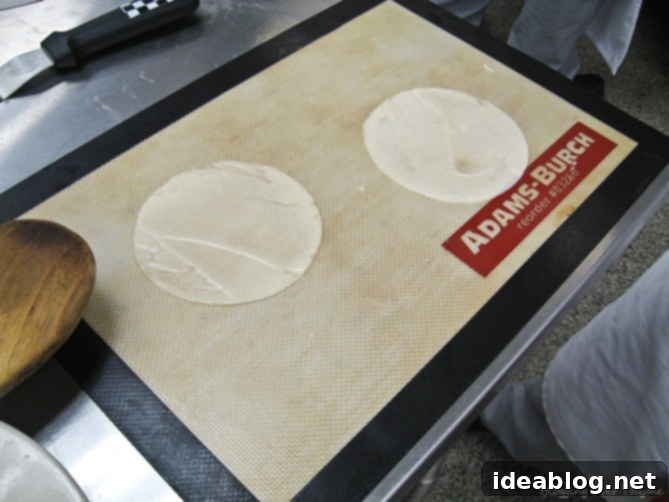
On a related note, the revelation that Crème Anglaise serves as a magnificent and remarkably simple base for homemade ice cream was particularly delightful. Its inherent richness, coupled with its delicate vanilla flavor, translates effortlessly into a wonderfully luxurious vanilla ice cream that is both deeply satisfying and surprisingly straightforward to prepare. This reinforces the profound idea that mastering fundamental techniques in a comprehensive culinary program unlocks a multitude of creative possibilities and empowers us to innovate with confidence.
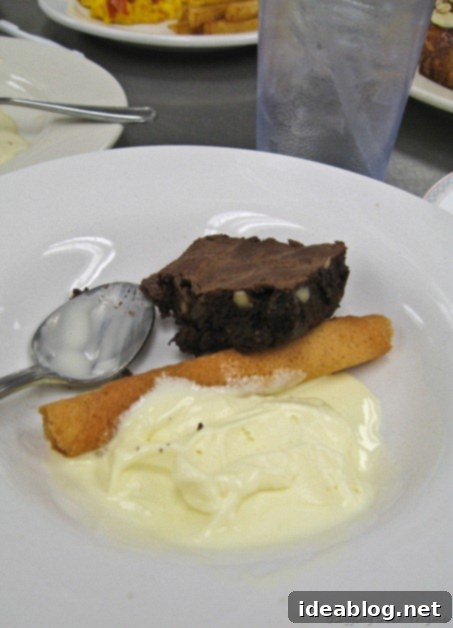
Reflections on the Culinary Journey: Reaching the Halfway Mark
As the bustling day drew to a close, Chef Brian delivered a poignant reminder: tomorrow would officially mark the halfway point of **Phase I** of our intensive culinary program. It’s truly astonishing how quickly time has flown by, each day packed with intensive learning, the acquisition of new skills, and the creation of countless delicious and complex dishes. Every lesson brings new challenges and deeper insights into the intricate world of professional cooking, pushing us to constantly refine our techniques and broaden our understanding.
With a small dusting of snow expected overnight in D.C., I’m hopeful my early morning commute won’t be disrupted. The thought of more culinary adventures, diverse ingredients, and intricate recipes awaits, and I’m eager to return to the kitchen to continue this incredible journey. Be back soon for more updates from our challenging yet immensely rewarding culinary school experience, as we delve further into the exciting realm of gastronomy!
